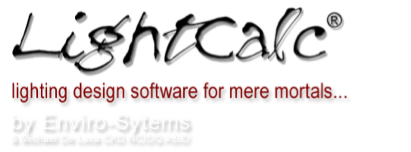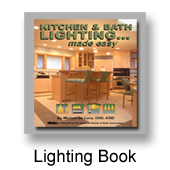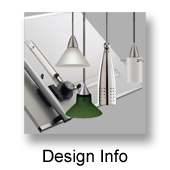Beam Angle
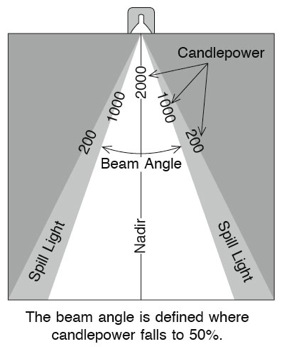
It is the beam angle we are concerned with when it comes to spacing one directional lamp to another.
The Beam Angle is found in the lamp manufacturers' lamp specifications.
Candlepower (Cp)
Candlepower is expressed in candelas. Confusion is caused for some when one manufacturer lists a lamps candlepower as "Center-Beam CandlePower" while another notes it as "Mean Candlepower" while still another uses "Candela" as the heading for the same information in their lamp specifications. Any of these listings refer to the lamp candlepower and are considered to be the same.
Candlepower is used in the Inverse Square Law calculation.
Some texts indicate that 1 candela = 12.57 lumens; do not try to convert lumens to candelas using this formula. Results will be inaccurate.
Color Temperature
- Cool lamps range from: 3,600k to 6,500k
- Neutral lamps range from: 3,000k to 3,600k
- Warm lamps range from: 2,700k to 3,000k
- Fluorescent lamps are available in Cool, neutral, & warm.
- Halogen lamps are considered neutral.
- Incandescent lamps are considered warm.
A properly selected lamp will have appropriate color temperature and provide a good CRI (color rendition index).
Lamps must reproduce the colors in the room properly. Without a lengthy discussion as to how it all works, just remember the following:
For task, accent, and art lighting use halogen lamps. PAR halogen or MR16 lamps (all of which are halogen) do an excellent job. For art, MR16 lamps are preferred since they throw their heat back and away from the art.
For general lighting, use PAR halogen lamps or compact fluorescent. Compact fluorescent lamps should be about 3500 kelvin (they range from 2700 - 6500 kelvin) to approximate the color of halogen lighting which may be used elsewhere in the room. Doing this ensures that all like colored objects will look the same.
These pictures are intended to show the quality of colors illuminated by various lamps.
Represented within the limits of modern monitors.
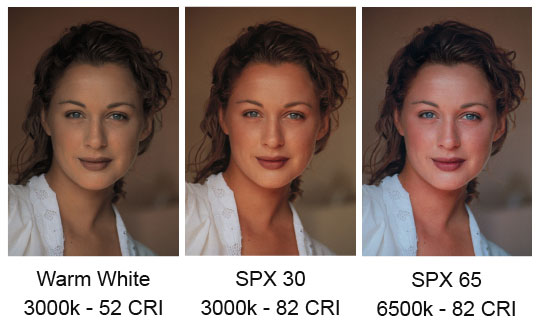
When using other types of fluorescent, remember to use lamps that are over 80 CRI (color rendition index) AND between 3000 - 3500 kelvin. All compact fluorescent lamps are over 80 CRI. CRI rates the lamps ability to reproduce an objects color accurately. Lamps falling outside these recommendations, in my opinion, destroy color!
CU Coefficient of Utilization
CRI - Color Rendition Index
- Fluorescent lamps are available in 50, 60, 70, 80, & 90 CRI.
- Incandescent and incandescent halogen lamps are 99 CRI.
A properly selected lamp will have good color rendering properties and be of an appropriate color temperature.
Distance (D)
Efficacy
Fixture
Fluorescent Phosphors
Traditional Halophosphors are inexpensive coatings which usually provide the entire spectrum of light. But, there is a trade-off between color rendering and lumen output. Poor color rendering lamps such as "warm white" and "cool white" have high lumen output. Good color rendering lamps such as "warm white deluxe" and "cool white deluxe" have low lumen output.
Prime Color or Tri-Phosphors are very expensive coatings with good color rendering and high lumen output. Lamps of this type are produced under the trademark, Ultralume.
Double-Coat lamps Have a coat of halo-phosphor and a coat of tri-phosphor. Double-coat lamps which have a thick tri-phosphor coat are fairly expensive but have very good color rendering properties. They are known by the trademarks SPX, Designer 800 series, etc.. Double-coat lamps with a thin tri-phosphor coat are much less expensive, but still have full light output and reasonably good color rendering. These lamps are known by the trademarks SP, SPEC, Designer, and others.
Rare Earth Phosphors Have a thin and thick coat of rare earth phosphors and are just becoming available. The CRI for these lamps will be 70, 80, and 90 and in a variety of color temperatures.
FootCandle (Fc)
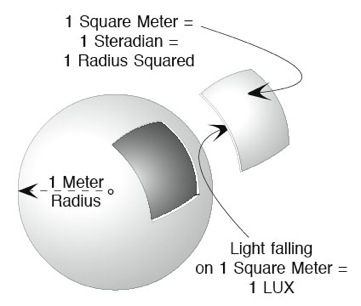
Note: One footcandle is equal to the amount of light provided by an ordinary wax candle on a spherical surface with an area equal to one square foot one foot away from the flame.
To convert Fc to Lux, use the formula:
Lux = Fc x 10.76
To convert Lux to Fc, use the formula:
Fc = Lux x .0929
If artwork is to be incorporated into the space it must receive 5 times the amount of light as the surrounding space. This gives the art the perception of being highlighted or accented.
See Chapter 1, Lighting Concepts, for more information on footcandles and Chapter 4, Lighting Measurements, for details on how to determine footCandles for a room and how they are used in the Inverse Square Law and Lumen Method calculations.
Footlambert
Inverse Square Law
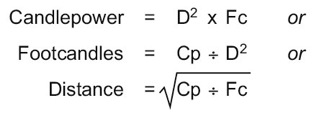
Example: an island counter is 3' high in a kitchen with an 8' ceiling height. Recessed cans are to be used with a lamp rated at 1150 candlepower. The distance from the lamp to the counter surface is approximately 5'. By squaring the distance (D2) between the counter and the lamp (5' x 5' = 25'), then dividing it into the lamps rated candlepower (1150), the footcandle level at the counter surface is found to be 46.
Lamp
Light
Line Voltage
Low Voltage
Lumen
Lumens are used in the Lumen Method calculation to determine the number of fixtures necessary and their spacing to maintain a given footcandle level as prescribed by the IES (Illuminating Engineering Society).
Some texts indicate that 1 candela = 12.57 lumens; do not try to convert lumens to candelas using this formula. Results will be inaccurate.
Lumen Method
Luminaire
Lux
Europeans manufacture many lighting products that are used in the states. Rather than learn the entire metric system of lighting measurements, do the calculations found in this book using footcandles, convert the results to lux using the factor below, then select the fixture or lamp in its metric equivalent.

Note: One lux is equal to the amount of light provided by an ordinary wax candle on a spherical surface with an area equal to one square meter one meter away from the flame.
To convert Lux to Fc, use the formula:
Fc = Lux x .0929
To convert Fc to Lux, use the formula:
Lux = Fc x 10.76
Nadir
Photometry
RCR - Room Cavity Ratio
Reflectance
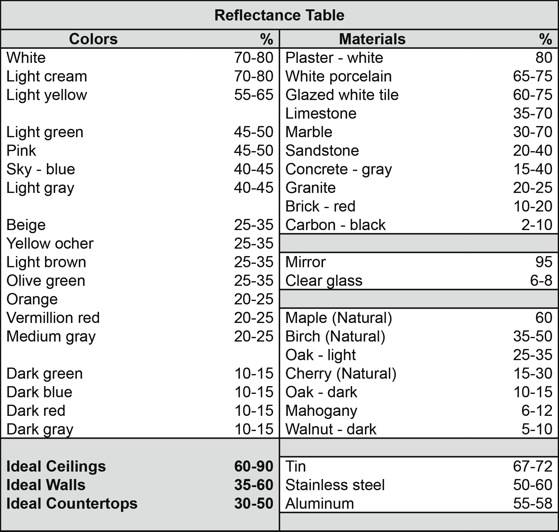
Spacing
Spacing should be at least equal to the beam diameter at the workplane to evenly maintain the footcandle level throughout a space. By decreasing this dimension the footcandles are increased; by increasing the spacing the footcandles are reduced.
Spacing Ratio
Spill Light
Spill light is viable light, though not enough to consider for lamp spacing, it is enough to provide adequate illumination to wall cabinet fronts in a kitchen, for example. It is also useful as a "buffer zone" when ideal spacing can't be achieved due to existing ceiling joists locations, etc.
Steradian
Watts
A lamp should be chosen based on its candlepower or lumen rating which indicates the light energy intensity of the lamp. Only then should wattage be considered to find the most economical lamp among those lamps powerful enough to provide the proper footcandle level on the workplane.
Workplane
For a kitchen, the countertop is the workplane at 3 feet above the floor, the bath can be anywhere from 2 1/2 to 3 feet, a dining room or desk is 2 1/2 feet. When there is not a specific surface upon which an activity will take place, such as in a family or living room, a 2 1/2 foot workplane height is assumed. Whether you are calculating general or task illumination, the light level is determined in footcandles measured at the workplane height.
Glossary
